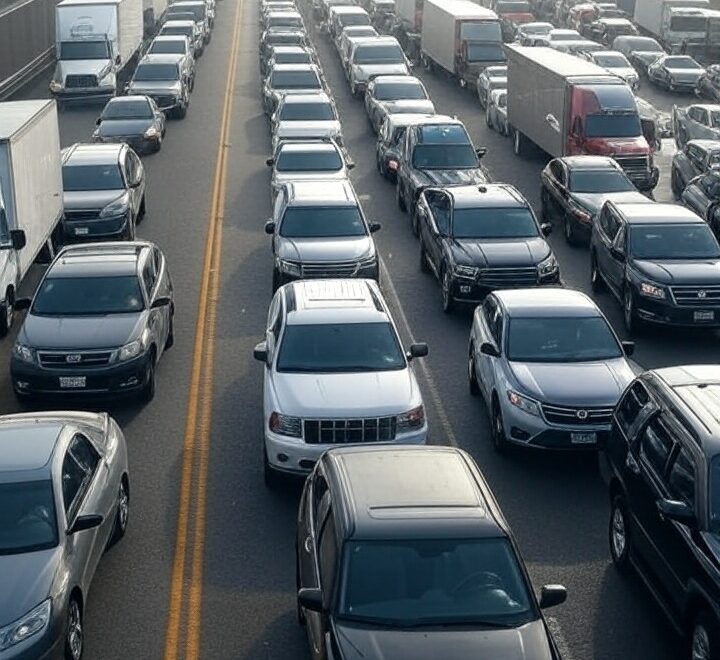5 Worst Traffic Jams in US History
May 31, 2025
The 5 Worst Traffic Jams in U.S. History: Causes, Impacts & Lessons Learned
From blizzards and music festivals to mega-hurricanes, America’s worst gridlocks reveal as much about human behavior and emergency planning as they do about asphalt and automobiles. Below we examine five historic traffic nightmares, why they happened, how bad they became, and what changed afterward.
1. Chicago’s “Blizzard of ’67”
- When: January 26–27, 1967
- Where: Greater Chicago, IL
- Why it happened: A record 23-inch snowfall in 29 hours overwhelmed snow-removal resources and stranded commuters.
- Severity: ≈ 20 000 abandoned cars + 1 100 buses; virtually every transport mode shut down.
- Aftermath: Chicago created priority snow routes, expanded its salt-spread fleet, and formalized early-dismissal protocols.
2. Woodstock Festival Gridlock
- When: August 15–17, 1969
- Where: Bethel, NY (NY State Thruway & NY-17B)
- Why it happened: An event planned for 50 000 drew nearly 500 000, swamping rural two-lane roads.
- Severity: Thruway paralysis for 20 miles; 8-hour delays; many attendees abandoned vehicles and walked.
- Aftermath: Modern mass-events now require multi-agency traffic plans, park-and-ride shuttles, and real-time media alerts.
3. Hurricane Rita Evacuation (Houston)
- When: September 21–24, 2005
- Where: I-45 & regional freeways, Houston, TX
- Why it happened: A late, blanket evacuation order for 2.5 million residents; contra-flow lanes opened too late; fuel shortages.
- Severity: 100-mile bumper-to-bumper line; up to 36-hour trips in 100 °F heat; 107 deaths linked to evacuation conditions.
- Aftermath: Texas adopted phased, zip-code evacuations, roadside fuel depots, and earlier contra-flow triggers.
4. Atlanta’s “Snowpocalypse”
- When: January 28–29, 2014
- Where: Metro Atlanta, GA (I-75/85, I-285, surface streets)
- Why it happened: Only 2 inches of snow, but schools and offices released everyone simultaneously; untreated roads iced over within an hour.
- Severity: 12- to 18-hour gridlock; thousands abandoned cars; students slept in buses and classrooms.
- Aftermath: Georgia now pre-treats interstates, staggers dismissals, and issues earlier stay-put alerts.
5. Hurricane Irma Statewide Evacuation (Florida)
- When: September 6–9, 2017
- Where: I-95, I-75 & Florida’s Turnpike (northbound)
- Why it happened: Irma’s forecast covered the entire peninsula, prompting 6.5 million people—the largest evacuation in state history—to leave at once.
- Severity: 10- to 15-hour drives on normally 4-hour routes; widespread fuel shortages despite shoulder-use plan.
- Aftermath: FDOT expanded emergency shoulder corridors, pre-contracts fuel escorts, and promotes “evacuate tens of miles, not hundreds.”
Key Take-Aways Across All Five Mega-Jams
| Theme | What Went Wrong | What Changed Afterward |
|---|---|---|
| Sudden, simultaneous demand | Everyone hit the road at once—blizzards, concerts, hurricanes. | Staggered releases, phased evacuations, & shelter-in-place orders. |
| Infrastructure constraints | Narrow rural roads, limited plows, single northbound corridors. | Investment in contra-flow, hard-shoulder running, pre-treated snow routes. |
| Poor information flow | Drivers lacked real-time updates on fuel, closures, alternate routes. | Statewide 511 systems, social-media alerts, EMS patrols. |
| Human factors | Panic evacuations, fuel shortages, abandoned vehicles. | Fuel-staging contracts, clearer public messaging, roadside assistance. |
Conclusion
The worst traffic jams in U.S. history weren’t simply roadway failures—they were planning and communication failures under stress. Each catastrophe rewrote the emergency-management playbook, reminding us that to keep people safe we must move them early, move them smart, and keep them informed.
References
- Chicago History Museum. “The Blizzard of 1967.”
- NOAA / NWS. “Chicago’s Largest Snowfall on Record.”
- History.com. “Photos of History’s Worst Traffic Jams.”
- The Columbian. “Five Myths About Woodstock.”
- Houston Chronicle. “How Rita Anxiety Led to the Worst Gridlock in Houston History.”
- CDC, Public Health Reports. “Lessons Learned from Hurricane Rita.”
- The Atlantic. “How Two Inches of Snow Created a Traffic Nightmare in Atlanta.”
- TransportationOps.org. “Emergency Shoulder Use During Hurricane Irma.”
- Miami Herald. “Gov. Scott Orders Review of I-75 Evacuation Route After Irma.”

